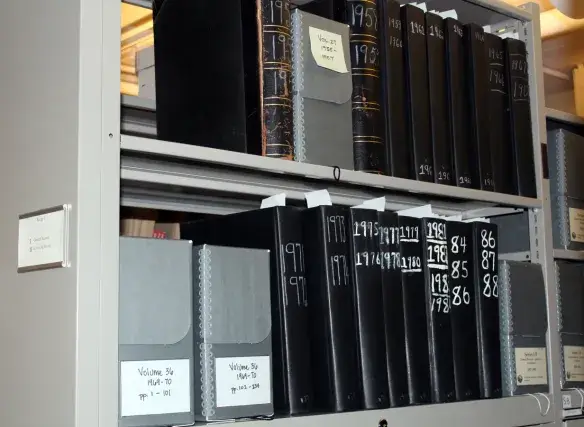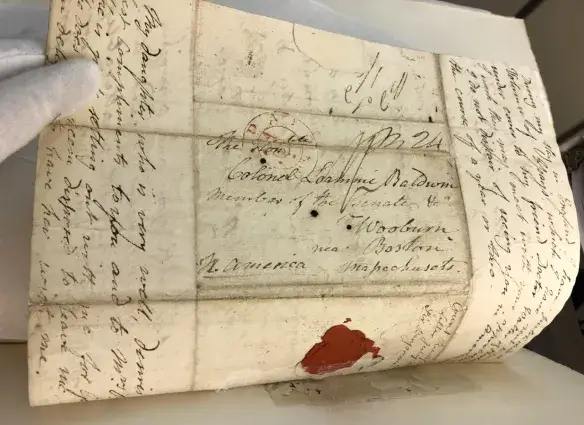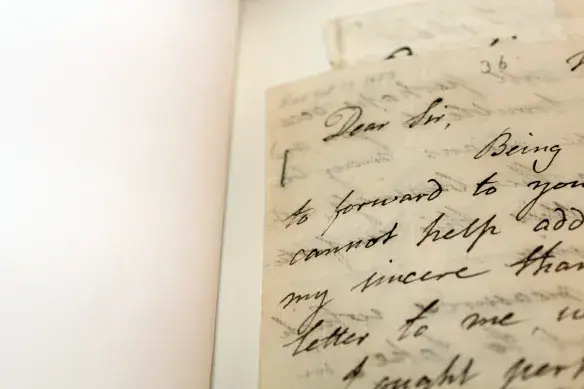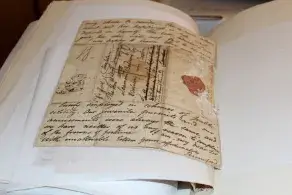Since the founding in 1780, the American Academy has conducted business through letters, announcements, and other forms of communication. All such material was the responsibility of the Corresponding Secretary, one of the original officers of the Academy. Beginning sometime in the late 1800s, incoming letters were pasted into bound scrapbooks for safekeeping, which the Academy referred to as “letterbooks.” This practice continued until 1988, when staff began saving correspondence in folders. These letterbooks are some of the most important among the Academy’s earliest records.

However, these large volumes cause damage to the documents due to their unwieldy size and the acidity of their support pages. Some of the adhesives used to affix the documents to the support pages have degraded over time, leaving orangish “burn” marks on the pages or creating a potential for loss as the items detach from the supports. Additionally, the size of the volumes and the adhesives prevent digitization of the materials at a sufficient quality for use.
Two previous grants supported the conservation of the first nine volumes of letterbooks, in which the original documents were carefully removed from the support pages, cleaned, and placed in proper archival folders. The documents were also digitized during the conservation treatment. The images were uploaded to the Academy’s website and made accessible through finding aids for each of the volumes: https://www.amacad.org/archives/browse.
Because the correspondence contained within these volumes form such a significant part of the Academy’s historical record—particularly as regards its earliest interactions with its Members—the Academy sought support for a two-year project to conserve and digitize the remaining thirty-five volumes spanning 1898 to 1988 in the same manner.

Once again the Academy has been fortunate to procure for this project the conservation and digitization services of the Northeast Document Conservation Center (NEDCC) in Andover, MA. The materials were transferred to NEDCC in early September.
Documents will be cleaned and removed from support pages either through immersion in a filtered water solution or surface cleaning and solvent application. Tears and folds will be mended with Japanese paper and starch paste, and folded documents will be flattened. Those documents which have not yet been digitized will be scanned before all items are rehoused in their archival folders and boxes.
The support for this project also provides for the treatment of materials related to one of its earliest members and donors. The Academy’s Special Collections includes materials related to the family life of Benjamin Thompson, Count Rumford.
Sir Benjamin Thompson, Count Rumford (1753–1814; elected 1789, FHM) was an American-born thermodynamic physicist, military officer and reformer, and inventor. After being elected a Foreign Honorary Member in 1791, Rumford donated $5000 in stock to the Academy in 1796 which later formed the basis of the Rumford Prize.
Sarah (“Sally”) Thompson (1774–1852), the daughter of Count Rumford by his first marriage to Sarah Rolfe, was an amateur writer of poetry, short stories, and biographical sketches. After the death of her mother, Thompson moved to Europe to be with her father and spent decades of her life abroad in London and Paris. She inherited the title Countess Rumford from her father, and eventually returned to her hometown of Concord, New Hampshire and lived as an independent woman of means.

The Rumford Family Collection includes six volumes of letterbooks, arranged in rough chronological order dating from 1775-1870 (bulk 1844-1854). The majority of the materials is correspondence from Sarah Thompson, Countess Rumford, to James Fowle Baldwin (1782-1862; elected 1841). The letters concern her international and financial affairs (such as the Bavarian pension she was entitled to through her father) as well as the management of her estate in Concord. Her letters are a blend of personal and professional, as Baldwin was both a primary business associate as well as a lifelong friend. In addition to Thompson’s letters, this collection includes Baldwin’s lists of her expenses, as well as a few documents related to her father, Count Rumford.
The letterbooks were compiled in the mid-twentieth century as part of an Academy project to reissue a five-volume set of Count Rumford’s works. However, like the Academy’s letterbooks, the original manuscripts were affixed to the ledgers’ pages with a variety of adhesives, and some even include metal staples and pins. Many pages feature documents layered on top of one another, making the volumes difficult to use.

The Rumford volumes will be conserved in the same manner and will also be digitized. The Academy staff are currently investigating online platforms to harness the power of crowdsourcing to transcribe the letters of Sarah Thompson and her circle.
Stay tuned for updates from this exciting project!
